
Olearia axillaris, commonly known as coastal daisy-bush, coast daisy-bush or coastal daisybush is a species of flowering plant in the family Asteraceae and is endemic to coastal areas of Australia. It is an erect, bushy shrub with densely cottony-hairy branchlets, aromatic, linear to narrowly elliptic or narrowly lance-shaped to egg-shaped leaves with the narrower end towards the base and small white and yellow, daisy-like inflorescences.

Leucopogon obovatus is a species of flowering plant in the heath family Ericaceae and is endemic to the southwest of Western Australia. It is an erect shrub with hairy young branchlets, variably-shaped, simple leaves, and erect clusters of 3 to 15 white, bell-shaped flowers on the ends of branches and in upper leaf axils.

Rhadinothamnus euphemiae, is a slender, small, upright shrub with needle-shaped branchlets thickly covered with silvery scales and tubular greenish-purple tubular flowers throughout the year. It is endemic to the south coast of Western Australia.
Lasiopetalum compactum, is a species of flowering plant in the family Malvaceae and is endemic to the south-west of Western Australia. It is an erect shrub with leathery, narrowly oblong leaves and cymes of white to pinkish flowers.
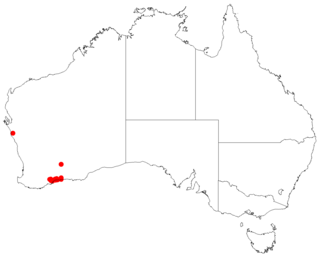
Styphelia conchifolia is a species of flowering plant in the heath family Ericaceae and is endemic to the south-west of Western Australia. It is an erect shrublet with many branches, more or less round leaves near the ends of branchlets, and white, tube-shaped flowers arranged near the ends of leafy twigs.

Styphelia cordifolia, commonly known as heart-leaved beard-heath, is a species of flowering plant in the heath family Ericaceae and is endemic to Australia. It is an erect shrub with broadly egg-shaped to round leaves, and white, tube-shaped flowers, the petals bearded on the inside.
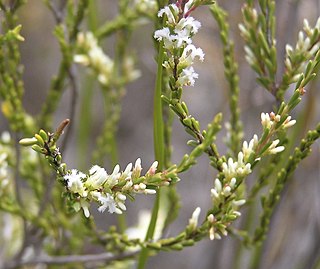
Styphelia corynocarpus is a flowering plant in the family Ericaceae and is endemic to the south-west of Western Australia. It is an erect, open shrub with narrowly egg-shaped to narrowly elliptic leaves, and white flowers arranged in groups of up to five in leaf axils.
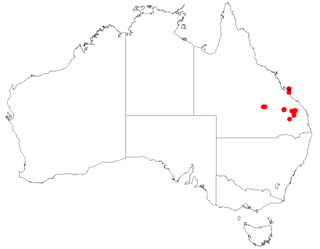
Styphelia flexifolia is a species of flowering plant in the family Ericaceae and is endemic to south-east Queensland. It is a rigid shrub with many softly-hairy branchlets, crowded, sharply-pointed linear to lance-shaped leaves, and small, white, bell-shaped flowers that are bearded inside.
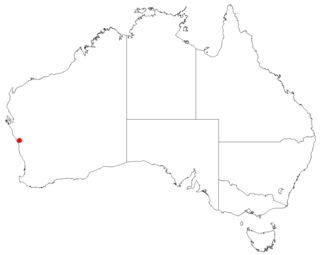
Leucopogon nitidus is a species of flowering plant in the heath family Ericaceae and is endemic to a small area in Western Australia. It is an erect, open shrub with hairy young branchlets, linear or very narrowly elliptic leaves and erect, compact clusters of 3 to 8 white flowers on the ends of branches and in upper leaf axils.

Leucopogon virgatus, commonly known as common beard-heath, is a species of flowering plant in the heath family Ericaceae and is endemic to south-eastern Australia. It is an erect to low-lying shrub with linear to narrowly lance-shaped or egg-shaped leaves, and erect clusters of three to seven white, tube-shaped flowers on the ends of branches and in upper leaf axils.
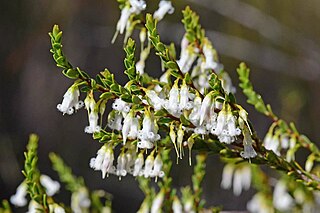
Leucopogon woodsii, commonly known as nodding beard-heath, is a species of flowering plant in the heath family Ericaceae and is endemic to southern continental Australia. It is a slender shrub with more or less erect, egg-shaped leaves, and pendent white, tube-shaped flowers with densely bearded lobes.
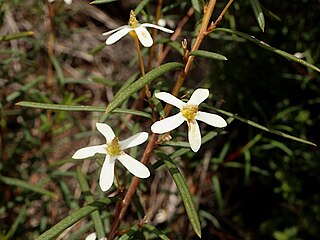
Ricinocarpos glaucus is a species of flowering plant in the family Euphorbiaceae and is endemic to the south-west of Western Australia. It is an erect, monoecious or dioecious shrub with linear or narrowly oblong leaves and male and female flowers arranged singly or in small groups.

Styphelia capillaris, commonly known as Horts' styphelia, is a species of flowering plant in the heath family Ericaceae and is endemic to a small area of south-western Western Australia. It is a dense, spreading shrub with narrowly egg-shaped to narrowly elliptic leaves and white flowers arranged singly or in pairs in leaf axils.
Styphelia angustiflora is a species of flowering plant in the heath family Ericaceae and is endemic to a small area near York, in the south-west of Western Australia. It is an erect, compact shrub with sharply-pointed, narrowly egg-shaped leaves and white, tube-shaped flowers.
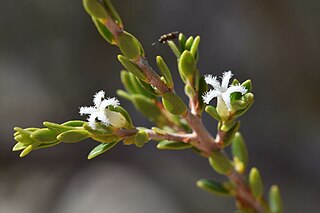
Styphelia ciliosa is a species of flowering plant in the heath family Ericaceae and is endemic to a small area of Western Australia. It is usually an erect shrub with narrowly elliptic to narrowly egg-shaped leaves with the narrower end towards the base, and white flowers usually arranged in pairs in leaf axils.
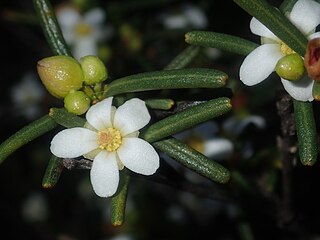
Ricinocarpos psilocladus is a species of flowering plant in the family Euphorbiaceae and is endemic to the west coast of Western Australia. It is an erect, open, monoecious or dioecious shrub with linear to narrowly oblong or narrowly egg-shaped leaves, and white or yellow flowers arranged singly, or with two to five male flowers, or a single female flower surrounded by up to three male flowers.
Styphelia deserticola is a species of flowering plant in the heath family Ericaceae and is endemic to inland Western Australia. It is an erect shrub with sharply-pointed, narrowly egg-shaped leaves and white or pale cream-coloured, tube-shaped flowers usually arranged in groups of 2 or 3 in leaf axils.
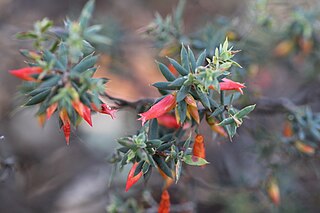
Styphelia epacridis is a flowering plant in the family Ericaceae and is endemic to the south-west of Western Australia. It is a straggling shrub with lance-shaped or linear leaves with a sharp point on the tip, and red, tube-shaped flowers arranged singly in leaf axils.
Styphelia exserta is a species of flowering plant in the heath family Ericaceae and is endemic to the south-west of Western Australia. It is an erect shrub with broadly egg-shaped leaves, and white, tube-shaped flowers.
Styphelia filamentosa is a species of flowering plant in the heath family Ericaceae and is endemic to a small area in the south-west of Western Australia. It is a low, compact, spreading shrub with egg-shaped to narrowly elliptic leaves, and white, tube-shaped flowers arranged singly, or in groups of up to four in leaf axils.














